Our glutes are a large, strong muscle group.
Because of that, you want to use both heavy loads and lower rep ranges for certain lifts while complementing those moves with slightly lower loads and higher reps that allow you to focus on that mind-body connection.
You want moves that may be more compound exercises, like the lunge, but also moves that are more targeted, like the weighted glute bridge.
And by using both types, you can also implement not only 2 drivers of muscle growth (mechanical tension AND muscle tissue damage) to get better strength and muscle gains faster, but you can also target both your upper and lower glute max fibers by using both hip and head driven movements!
Generally hip drivers, moves like the hip thruster and glute bridge will create more mechanical tension. You can usually use both heavy loads BUT slightly lighter loads for more reps to build that mind-body connection.
While generally the head drivers, like the deadlifts and lunges, create more muscle tissue damage, and your focus should be more on adding loads and varying reps and tempos over the mind-body connection. These moves can also often make you a bit more sore.
Below I’ll go over the 5 moves in the video and the reasons to use each!
Breaking Down These 5 Must-Do Glute Moves

Barbell Hip Thruster:
If you want to gain muscle and build strength, this move is a must-do glute move.
It’s great for people looking for both aesthetic changes and improvements in sports performance.
It can also help you strengthen your glutes to avoid lower back, hip and knee pain and can be a great way to strengthen your legs while working around knee injuries if lunges and squats are contraindicated.
This hip driver move, while it targets both the upper and lower glute maximus fibers (with maybe a slight bit more of a focus on those upper glute fibers), will also work your hamstrings and quads.
Especially as you add loads, it isn’t bad to feel those two other muscle groups working as well, but you do want to make sure you aren’t perpetuating compensations by ONLY feeling those other muscle groups working.
It’s why I love including this move with lower reps AND heavier loads once a week as a primary lift, but also why I often include it as an accessory move with lighter loads and more reps to focus on the mind-body connection later in a second leg day workout each week.
You can also vary this movement up to create more metabolic stress, and even be a better activation or accessory lift by using bands instead of a barbell.
A double banded variation, with a mini band around your legs and a big band across your hips, is a great option!
Weighted Glute Bridge:
If you want to really isolate those glutes, and work both the upper and lower glute maximus fibers, to strengthen them, this is a lift you need to include.
A hip driven, more isolated movement, the glute bridge makes it easier to prevent other muscles from compensating even as you add loads.
It is a great move to include if you often feel your hamstrings or quads taking over during other heavy lifts and you need to target those glutes for strengthening.
HOWEVER, there is still some hamstring involvement so make sure you are driving straight up and even using a posterior pelvic tilt during the bridge.
If you think about even driving your knees toward your toes as you bridge up, while keeping your heels down, you can focus on using those glutes to drive the hip extension.
If you find yourself really struggling to feel your glutes working, as this move is a great way to improve your mind-body connection, add a mini band right below or above your knees.
By pressing out on the band, you will activate your glute medius and that, in turn, will help you activate your glute maximus better.
Kettlebell Swing:
This is a great hip hinge, hip driven movement to work your entire posterior chain – your back, glutes and hamstrings!
It is also a great glute move to include during a more metabolic focused workout as it will work your glutes while getting your blood pumping.
You can focus more on glute power, if you do a very explosive move with a challenging weight for fewer reps, or you can focus more on strength endurance, if you use a lighter, but still challenging, load for more reps.
The kettlebell swing though is a very technical move so be very conscious to engage your lats and proper push your butt back as you hinge or you will overload your lower back.
If your lower back is taking over, guess what isn’t benefiting as much from the move? Your glutes!
So make sure you’ve learned a proper hip hinge first and also make sure you aren’t turning this into a squat.
Single Leg Deadlift:
This posterior chain focused hip hinge move is also a great exercise to improve your stability and balance.
The single leg deadlift will target your glutes, hamstrings, back and abs and is a great accessory move to include because it can help you work to correct any imbalances between both sides since it is a unilateral movement.
This exercise is a “head driven” movement and will create more muscle tissue damage and often lead to more soreness as you add heavier loads. It will also target those lower glute maximus fibers a bit more than the upper glute max.
Just make sure to progress this move slowly as you want to make sure you can fully hinge correctly and sit back to load your glutes while staying balanced.
Beginners may do a hand balancing technique or even put a slider under one foot so there isn’t as much of a balance challenge to start.
And like with all deadlift variations, make sure you don’t feel your lower back taking over.
Kettlebells or dumbbells can be great tools to start with as you can help yourself hinge correctly by lowering the weights down and back toward your instep or even your heel.
By hinging with a neutral spine while lowering the weights back toward the midline of your foot, you can avoid yourself shifting your weight forward or reaching out, which can often lead to you overloading your lower back!
Deficit Reverse Lunge:
Lunges are a great head driven movement to strengthen your entire leg.
They can make us more sore as they create more muscle tissue damage though.
By specifically using a reverse lunge variation, you can target your glutes more easily as well (especially working those lower glute maximus fibers).
And by adding in the deficit, you can work through a bigger range of motion.
This increased range of motion not only makes the move harder without even adding loads, but it also helps you improve your mobility and stability.
When we stretch and foam roll, we are working to improve our mobility and flexibility. Too often though we then go strength train through partial ranges of motion, or at least not the full range of motion we’ve built.
This only fights against our mobility and flexibility gains.
By adding in deficit lunges, or moves with a bigger range of motion, we can strengthen through the full range of motion we’ve worked so hard to build to KEEP the increased range of motion.
So with this move, not only are you strengthen your legs and glutes, but you’re also improving your mobility!
Plus, lunges are more unilaterally focused moves, which can also help us correct imbalances between our stronger and weaker sides to avoid injury!
Ready To Build Strong Glutes That Not Only Look Amazing But Help You Avoid Injury, Run Faster And Lift More?
Join my Glute Camp and implement all of these moves and techniques (and more!) with my workout cards!
Learn more about the Glute Camp.

